 |

Tools:








Is ToysRUs getting ready for an IPO?
Ever since TRU was taken private by Bain, KKR and Vornado in 2005, the investment community has been asking when, not if, TRU was going to go public again. Recent developments suggest that it could be as soon as early next year.
Firstly, the appointment of David Brendon as Chairman and CEO of TRU in July this year is a strong pointer. Mr. Brendon was not appointed because he is particularly good at toys or, at that, at any packaged consumer goods given his background as CEO of Valassis Communication, then as CEO of Domino’s Pizza and finally as Director of Athletics at the University of Michigan. However, what he does have is a gold plated record as an IPO strategist – he engineered IPOs for both Valassis and for Domino.
Secondly, his predecessor Antonio Urcelay was unquestionably much more qualified to manage ToysRUs’ turn around. His career with the company started in 1996 and included increasingly responsible executive positions which reached their zenith in 2013 when he was appointed CEO of ToysRUs worldwide. Not only are Mr. Urcelay’s qualifications as a toy executive beyond question, he was also incredibly successful in every position he held. And this includes his last stint with the company as its CEO. Hence his departure, and his replacement by David Brendon, cannot be seen as an indictment against his performance as CEO which suggests that other reasons were at work in engineering his departure.
Thirdly, ToysRUs as a company is today in much better shape than it had been for a number of years and all indications are that improvements already under way are working. Mr. Urcelay had put in place a plan and strategy that emphasized doing a better job with the basics of retailing, getting rid of fat, and focusing on the profit opportunities inherent in product selection – exclusives, private labels etc. Mr. Brandon said he planned to continue with many of those initiatives. “The company needs to put itself in a position where it can compete globally,” he said. “It’s about performance and execution.” So why bring in an IPO artist when his only task is to continue what his predecessor has already started?
Many analysts looked at the second quarter result and thought the company was falling off a cliff. This is definitely not the case once you look past the currency impact and just focus on the nuts and bolts of the company’s business. This is how ToysRUs organic sales, without the currency impact, stacked up for the first and second quarter:
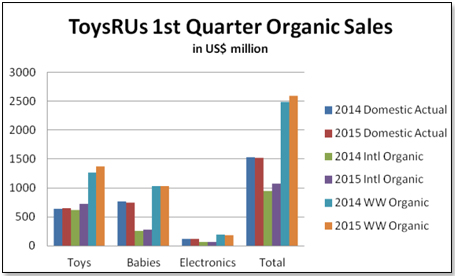
Source; SEC filings
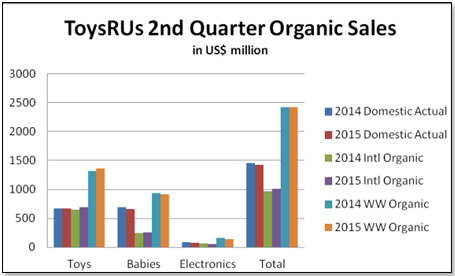
Source; SEC filings
As you can see, their core business, toys, grew in both quarters; their second leg, BabiesRUs, was flat to down and Electronics, mainly video games, were down in both quarters.
Basically, ToysRUs is facing in each of its three businesses one major competitor and it may be useful to look at the three components in more detail:
Toys:
As is implicit in the name, ToysRUs is mainly about toys. It is also the market leader if only by a whisker. At the end of August 2015, TRU had an estimated U.S. market share of 18.5% whereas Amazon had 18.4%. Even though TRU’s domestic toy business in the first six months of this year had grown by 1%, they had lost share in a market that had grown by about 4%:
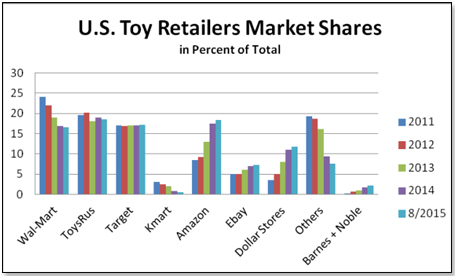
Source: Klosters Retailer Panel
Clearly, Amazon is gaining on TRU and the question is – why?
The conventional answer to this question is convenience. Why flog off to a store if you can order what you want from your computer at home? Yes, this is obviously one of the reasons but not the overriding one. The main reason is that TRU does not do as good a job as Amazon in terms of providing great choice at good pricing.
If you look at Amazon’s top toys in the Action Figure and Doll categories as an example, you will find that ToysRUs has only about half of Amazon’s top sellers in its assortment and those which it has are at considerably higher prices:
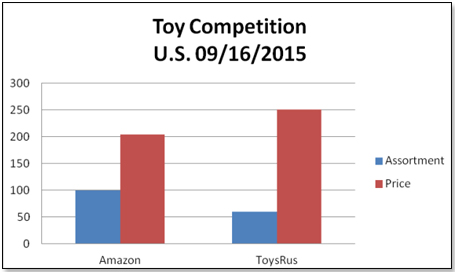
Source: Klosters Retailer Panel
This suggests two areas where TRU could readily improve its competitive standing - if they monitored Amazon’s toy assortment and firstly made sure they carried all of Amazon’s top selling products and secondly used them as a loss leaders to demonstrate to consumers that the company continued to offer the best selection at the best prices.
Also, Amazon beats ToysRUs in terms of consumer interest focused on toys. This becomes evident when looking at TickerTags tweet volume associated with Amazon + Toys [tan space below] on one hand and ToysRUs+ Toys [blue space] on the other:
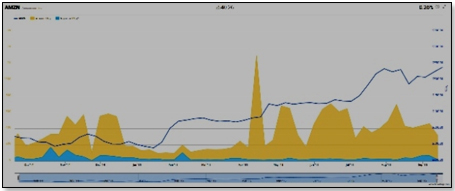
Source: www.tickertags.com
It is clearly no contest and these metrics suggest that ToysRus has to do a much better job in utilizing social media in reaching their potential consumers.
Incidentally, TickerTags.com uses data analytics to chart the social mention frequency of words and word groupings that represent a company's relevant products, brands, people or trending topics across Twitter. In other words, it tracks what people are talking about everyday. TickerTags, which has just had its beta launch, tracks tweet volume associated with publicly traded companies.
Baby Products:
Baby products are a very important part of ToysRUs’ consumer strategy on the premise that the expecting or young mother shopping for baby products would return at a later stage to also buy toys for the little guys. It is also the company’s second largest product category.
Performance this year has been modest with organic growth for the first six months at minus 0.6%. However, this sounds worse than it is. North America and Europe, the two largest baby food and diaper markets [in which ToysRUs is concentrated] were flat in 2014 and are expected to be marginally declining this year. In other words, ToysRUs pretty much maintained its market share.
However, the company is also facing greatly increased competitive pressure from Target Stores. Target appointed a new CEO, Brian Cornell, on July 31, 2014. Just a month into his job he declared that his strategy would be to emphasize a small number of categories that could help the chain stand out. "We've got to major in these signature categories and make some bold changes to re-energize those businesses," Mr. Cornell said in an interview. "All categories can't be prioritized the same. The areas that will get extra attention, investment and pressure are baby products, including diapers, clothes and gear; children products, including clothes and toys.” The competitive target for this strategy is ToysRUs.
If you look at Target’s top sellers in the Diaper and Baby Food categories, you will notice that ToysRUs has only about three-quarters of Target’s top sellers in its assortment but those which it has are very competitively priced.
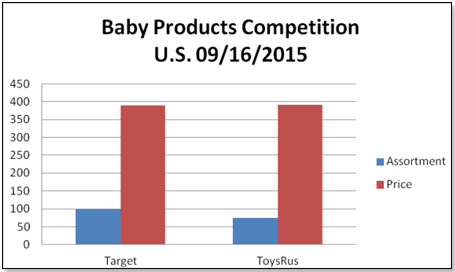
Source: Klosters Retailer Panel
As in the case of toys described further above, TRU could improve its performance by making sure that they carried all of Target’s top selling products, not only three-quarters. They might also consider using them as loss leaders to further cement their position in the category.
Also, Target continues to outdo ToysRUs in terms of consumer interest focused on baby products. This becomes evident when looking at TickerTags tweet volume associated with Target + Baby [tan space below] on one hand and ToysRUs+ Baby [blue space] on the other:
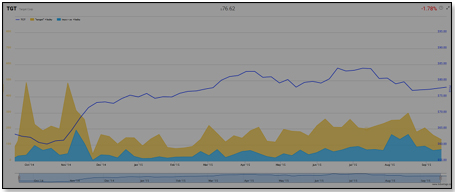
Source: www.tickertags.com
It does appear that Target’s lead over ToysRUs is narrowing which suggests that the latter may be catching up. Nevertheless, just like in the case of toys, ToysRus still has to do much more in strengthening its social media efforts.
Video Games:
Video Games are the main driver of TRU’s Entertainment Sector and are hence the focus of this analysis. The top competitor in this sector is GameStop, the largest worldwide video game brick-and-mortar retailer.
TRU during the first half of this year lost out to GameStop worldwide and suffered a market share decline in the U.S. Organic sales worldwide were down by 13.6% versus GameStop’s performance which was up by 2.26%. The U.S. software market according to NPD during the first half this year was down by 0.9% whereas TRU’s sales were down by 8.5%. In short, TRU did very badly in this sector so far this year.
Running the same assortment and price analysis as done further above for toys and baby products, we come up with the following picture:
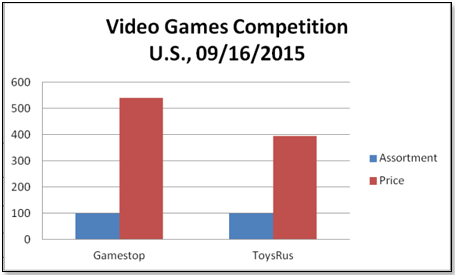
Source: Klosters Retailer Panel
TRU carried exactly the same products as GameStop’s top sellers and beat them handily at price. So why the dismal performance so far this year?
There are three reasons. One is the fact that GameStop does much better at social media reach. The tan space below denotes GameStop + Video Games whereas the blue space represents ToysRUs + Video Games.
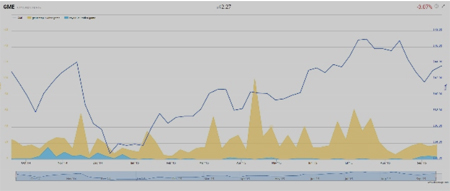
Source: www.tickertags.com
The second reason is that video games really have no place in a toy and baby product store. According to ESA’s [Entertainment Software Association] 2015 Sales, Demographic and Usage Data, the typical video game consumers are predominantly males aged between 18 and 60 years of age:
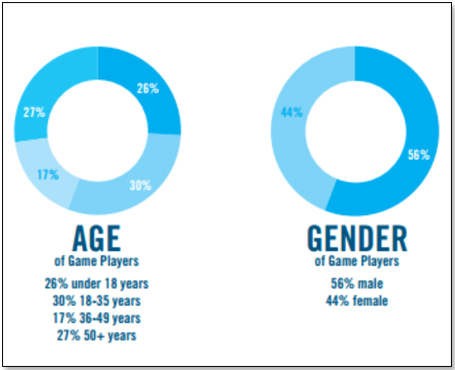
There is absolutely no reason for a adult male to be in a ToysRUs store except as company for his wife out baby shopping or his kids in the toy aisle.
The third and probably most important factor is that ToysRUs is not very good at selling video games. Unlike GameStop where the kids behind the counter are video game aficionados themselves and know exactly what they are doing when talking to a consumer, the TRU sales associates in the Electronics space really do not. Unlike toys and baby products where the consumer normally knows exactly what he or she is looking for, the sales effort for video games is typically a consultative one where the consumer asks questions, sometimes highly technical ones, and expects educated answers. They do not get these at ToysRUs.
In my opinion, ToysRUs would be much better off taking the space now devoted to Electronics and giving it to toys or party products.
Overall:
While not overwhelmingly good, ToysRUs’ performance has been significantly better so far in 2015 compared to the last few years – that is, with the exception of their Entertainment [Electronics] sector. The proof of the pudding of course is in their performance during the vital second half given the seasonality curve governing toys. Not so surprisingly, TRU management is keenly aware of this and recognizes that a possible 2016 IPO is only feasible if their top and bottom line results during the September to December period are markedly better than what they have been in the past.
The national buyers at competing retailers both in the U.S. and in Europe tell me that they are expecting a very major push from ToysRUs to achieve this, starting just about now. This push, in their opinion, will include greatly ramped up advertising and social media efforts, special promotions featuring exclusives and private label where margins are better, and sharper focus on competitive product selection.
 Writer's Bio: Writer's Bio: Lutz Muller is a Swiss who has lived on five continents. In the United States, he was the CEO for four manufacturing companies, including two in the toy industry. Since 2002, he has provided competitive intelligence on the toy and video game market to manufacturers and financial institutions coast-to-coast. He gets his information from his retailer panel, from big-box buyers and his many friends in the industry. If anything happens, he is usually the first to know. Read more on his website at www.klosterstrading.com. Read more articles by this author
THIS BANNER IS AN AD:

Back to TDmonthly's front page
|  |
Advertise on TDmonthly

|


